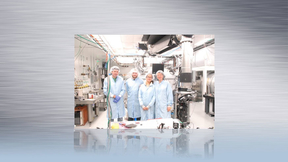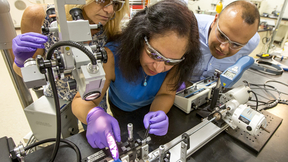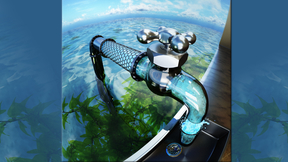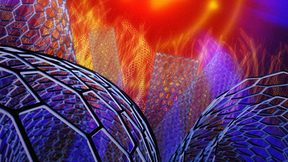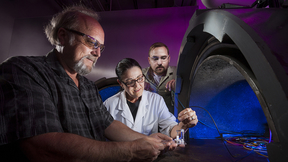Back
Physical and Life Sciences
Fast heat flows in warm dense aluminum
Thermal conductivity is one of the most crucial physical properties of matter when it comes to understanding heat transport, hydrodynamic evolution and energy balance in systems ranging from astrophysical objects to fusion plasmas. In the warm dense matter (WDM) regime, experimental data are very rare, so many theoretical models remain untested. But LLNL researchers have…
Reducing reflectivity in solar cells and optics with micro- and nanoscale structures
When it comes to solar cells, less is more -- the less their surfaces reflect a sun’s rays, the more energy can be generated. A typical fix to the problem of reflectivity is an anti-reflective coating, but that might not always be the best solution, depending on the application. Lawrence Livermore National Laboratory (LLNL) researchers have come up with guidelines for an…
Perfecting the spider's art to support NIF targets
Materials scientist Xavier Lepró can’t grow his "spider webs" fast enough to swing from skyscrapers like Spiderman, but he can best another web-maker, Mother Nature, when it comes to consistency. Lepró helped pioneer the spinning of spider-silk-like yarns for use in suspending target capsules inside NIF hohlraums. These yarns are even stronger than the silks spun by the…
Carbon nanotubes worth their salt
Lawrence Livermore (LLNL) scientists, in collaboration with researchers at Northeastern University, have developed carbon nanotube pores that can exclude salt from seawater. The team also found that water permeability in carbon nanotubes (CNTs) with diameters smaller than a nanometer (0.8 nm) exceeds that of wider carbon nanotubes by an order of magnitude. The nanotubes,…
Using real-world data, Lab scientists answer key questions about an atmospheric release
In the event of an accidental radiological release from a nuclear power plant reactor or industrial facility, tracing the aerial plume of radiation to its source in a timely manner could be a crucial factor for emergency responders, risk assessors and investigators. Utilizing data collected during an atmospheric tracer experiment three decades ago at the Diablo Canyon…
Lab scientist takes a leap in the dark
He could have been a professional trombone player in a jazz ensemble or a chef specializing in New Mexican cuisine. However, Michael Schneider took a very different path. He became an explorer looking for the meaning of the universe in the form of dark energy. With the help of the Large Synoptic Survey Telescope (LSST), due to come online in 2019, he plans to see more…
Shock front probed by protons
A shock front is usually considered as a simple discontinuity in density or pressure. Yet in strongly shocked gases, the atoms are ionized into electrons and ions. The large difference in the electron pressure across the shock front can generate a strong electric field. In experimental campaigns using the OMEGA EP laser at the Laboratory for Laser Energetics (LLE) at the…
Exposure to antibacterials from mother to child may cause adverse effects in development
Lawrence Livermore National Laboratory (LLNL) scientists have discovered that exposure to environmental levels of triclocarban (TCC), an antibacterial chemical common in personal care products like soaps and lotions as well as in the medical field, can transfer from mother to offspring and interfere with lipid metabolism. Ultimately, the findings could have implications…
Santer named American Meteorological fellow
Renowned Lawrence Livermore National Laboratory atmospheric scientist Ben Santer has been selected as a fellow by the American Meteorological Society. AMS membership is divided roughly evenly among the public, private and academic sectors. The opportunities for achievements that match the qualifications for fellow, namely "outstanding contributions to the atmospheric or…
It's something in the water: LLNL scientists extract hydrogen as potential fuel source
Lawrence Livermore National Laboratory (LLNL) scientists have developed a technique that helps extract hydrogen from water efficiently and cheaply. Hydrogen can be used as a clean fuel in fuel cells, which produce power, with water and heat as the only byproducts. As a zero-emission fuel, the hydrogen can be recombined with oxygen to produce electric power on demand, such…
Summer scholar purifies water with fibers
It all started for Mariana Lanzarini-Lopes as an undergraduate, cracking coconuts in the West Indies, seeing the effects of dysentery while working in a hospital in Africa and engineering a solar-powered refrigerator to keep medicine safe in Indian villages. This was the path that led the doctoral student in environmental engineering to join the fight to solve one of the…
Conductivity key to mapping water inside Earth
Hydrogen at elevated temperature creates high electrical conductivity in the Earth’s mantle. New work by Lawrence Livermore National Laboratory (LLNL) scientists shows the dispersal of water (incorporated as hydrogen in olivine, the most abundant mineral in the upper mantle), could account for high electrical conductivity seen in the asthenosphere (part of the upper mantle…
Carbon nanotubes stand at attention
Just as members of a marching band align themselves for a performance, carbon nanotubes create a similar configuration. Lawrence Livermore National Laboratory (LLNL) scientists recently used synchrotron X-ray scattering to fully capture the hierarchical structure in self-organized carbon nanotube materials from the atomic to micrometer scale. Their work, recently published…
Lab scientists dig in to geothermal systems
Lawrence Livermore National Laboratory (LLNL) scientists play a significant role in a new project aimed at removing technical barriers to commercialize enhanced geothermal systems (EGS), a clean energy technology with the potential to power 100 million American homes. In the $9 million Department of Energy (DOE) project, which is led by Lawrence Berkeley National…
Additive Manufacturing Meets Quantum
The November issue of Applied Physics Letters features work from LLNL’s Quantum Coherent Device Physics Group that applies the Lab’s expertise in additive manufacturing to advance quantum computing by entering a design space inaccessible to conventional fabrication. This work was the first demonstration of Ti-6Al-4V as a superconducting radio frequency cavity. Such…
Lab scientist earns award for plasma physics
Though Dmitri Ryutov formally retired from Lawrenece Livermore National Laboratory (LLNL) about a year ago, he maintains a close connection to the Lab via his visiting science professional (VSP) status. And for his work in plasma physics during his 22-year stint at LLNL and previous research at the Budker Institute of Nuclear Physics in Novosibirsk, Russia, Ryutov has…
Carbon nanotubes mimic biology
Proteins in lipid membranes are one of the fundamental building blocks of biological functionality. Lawrence Livermore researchers have figured out how to mimic their role using carbon nanotube porins. Using high-speed, atomic force microscopy (HS-AFM), the team showed that a new type of biomimetic channel — carbon nanotube porins (CNTPs) — also is laterally mobile in…
Detonation Science Blasts into a New Frontier
At Lawrence Livermore, a key aspect of stockpile stewardship includes fine-tuning and experimentally observing HE detonation processes and developing computer models to predict the behavior of different HEs. Over the last several decades, HE detonation science has progressed toward higher resolution experimental and modeling capabilities that explore initiation processes,…
Charcoal could limit uptake of radioactive elements into Marshall Islands food chain
Lawrence Livermore National Laboratory (LLNL) researchers have conducted a series of laboratory and field experiments that explore the effects of adding biochar, a porous charcoal that looks like black landscaping bark, to the soil to limit the cesium (Cs) uptake into foods grown in the Marshall Islands. From 1946 to 1958, the United States tested 67 nuclear weapons at…
Peering at the crystal structure of lithium
Elemental metals usually form simple, close-packed crystalline structures. Though lithium (Li) is considered a typical simple metal, its crystal structure at ambient pressure and low temperature remains unknown. Lawrence Livermore National Laboratory (LLNL) researchers recently came up with a technique to obtain structural information for Li at conditions where traditional…


